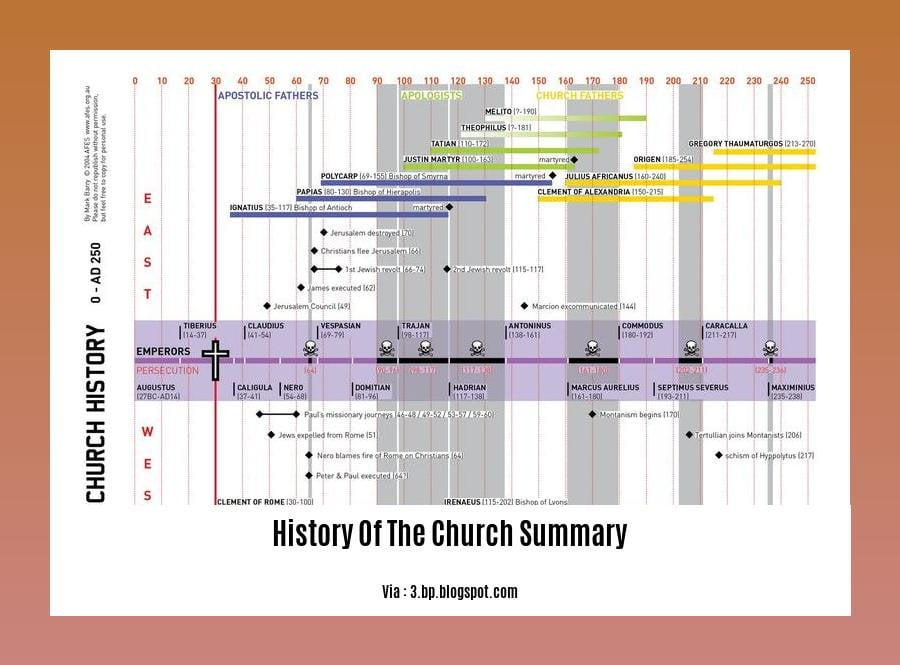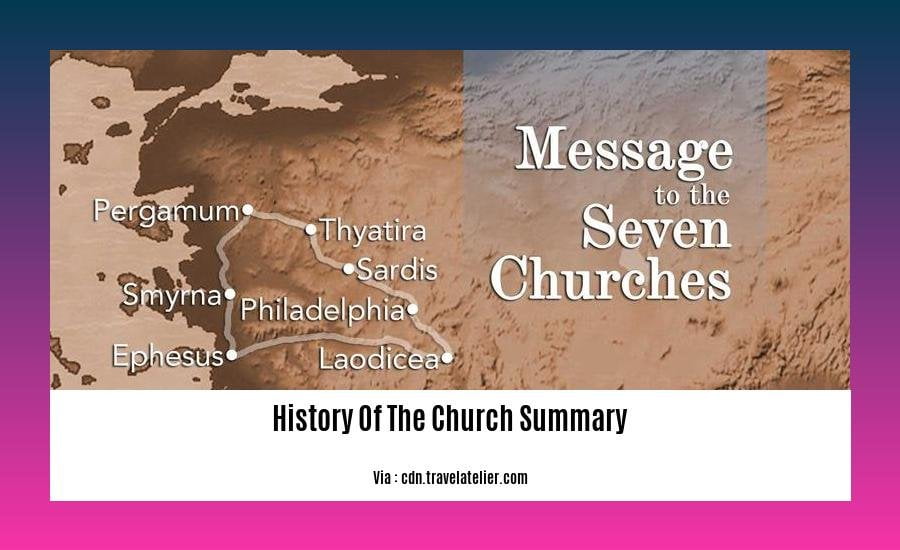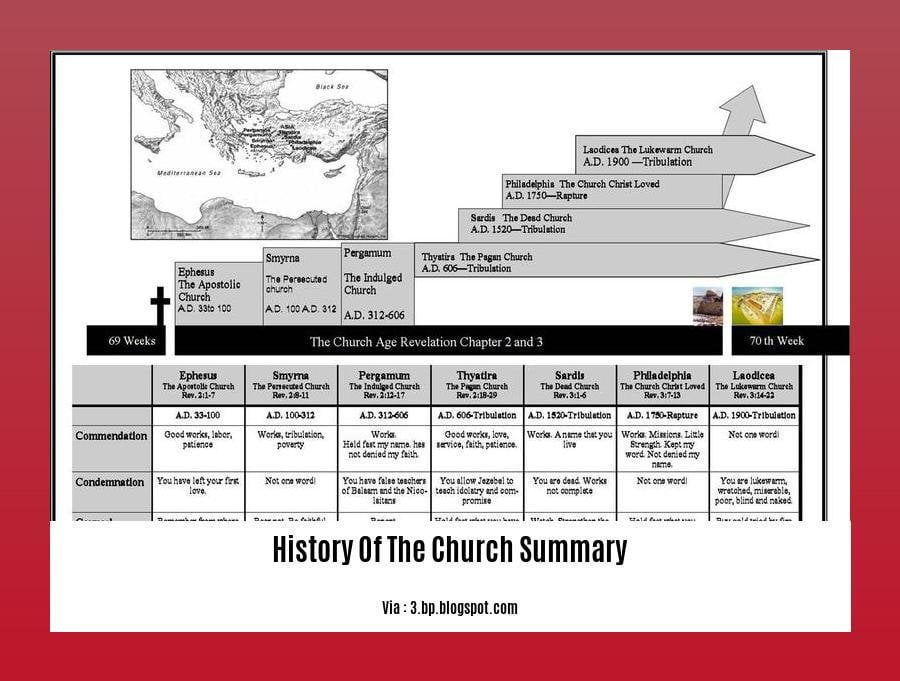A Historical Overview of the Church: Tracing Its Evolution Through the Ages [History of the Church Summary]: The church, an enduring institution that has shaped the course of human history, has undergone a remarkable evolution over many centuries. From its humble origins in the first-century Roman Empire to its transformation into a global religious force, the journey of the church has been marked by profound changes in beliefs, practices, and organizational structures. This concise summary encapsulates the key developments that have shaped the history of the church, offering a glimpse into its diverse traditions, influential figures, and lasting impact on society, culture, and faith.
Key Takeaways:
Church history focuses on studying Christianity’s development and the Christian Church’s evolution over time.
It originated around 30 A.D. when a group of Jewish converts and Jews followed Jesus Christ in Palestine after his resurrection.
Rapid spread led Christianity to become the dominant religion in the northern Mediterranean regions by the third century A.D.
Church history examines Christianity’s spiritual, social, and cultural aspects, as well as interactions with other religions and civilizations.
History of the Church Summary

For millennia, the church has been an institution that has influenced diverse aspects of society. This summary delves into the rich and captivating history of the church, surveying its development, evolution, and far-reaching impact.
A Testament to Faith and Endurance
The origins of the church trace back to the teachings of Jesus Christ, whose life and teachings ignited a spiritual movement within a small group of Jewish believers in Palestine. After Jesus’ resurrection, his followers, known as apostles, set out to spread his message of salvation and redemption. The church’s foundation was marked by a deep sense of community, shared values, and a commitment to the teachings of Christ.
From Persecution to Triumph: The Early Church
The early church faced numerous challenges, including persecution from the Roman Empire. Despite these trials, the faith’s resilience and unwavering commitment to spread the gospel prevailed. Missionaries such as Paul embarked on extensive journeys, establishing churches throughout the Mediterranean region. By the end of the 3rd century, Christianity had become the dominant religion in the northern regions of the Roman Empire.
A Period of Transformation: The Middle Ages
The Middle Ages saw the rise of the Catholic Church as a powerful institution. Monasticism flourished, and the establishment of monasteries and cathedrals played a pivotal role in preserving and transmitting knowledge and culture. During this time, the church also gained significant political influence, leading to the development of the Papal States in Italy.
Reformation and Renewal: A New Chapter Unfolds
The 16th century marked a pivotal shift in the history of the church with the Protestant Reformation. Martin Luther’s challenge to the Catholic Church’s authority and practices led to the emergence of Protestantism, resulting in the formation of new denominations and a diversification of Christian beliefs and practices.
A Global Reach: The Modern Era
In the modern era, the church’s presence expanded beyond its traditional strongholds. Missionaries ventured to distant lands, introducing Christian teachings and establishing communities worldwide. This global expansion led to a rich tapestry of cultural influences, enriching the church’s diversity and perspectives.
The Church’s Legacy: A Tapestry of Impact
Throughout history, the church has left an enduring mark on society. Its teachings have shaped ethical and moral principles, and its institutions have contributed to education, healthcare, and social welfare. The church’s involvement in the arts, literature, and music has enriched cultural traditions worldwide.
A Continuing Journey of Faith
Today, the church continues to evolve, navigating a diverse landscape of challenges and opportunities. As it enters the future, the church strives to remain faithful to its core teachings while embracing new perspectives and responding to contemporary issues. The enduring story of the church is one of resilience, adaptation, and the enduring pursuit of spiritual growth and transformation.
Enhance your understanding of TaylorMade’s impact on the golfing world by delving into the history of TaylorMade irons. Their innovative designs have revolutionized the game and continue to shape its future.
Discover the rich history of textile printing through the ages, from its ancient origins to its modern manifestations. Explore the evolution of techniques and materials that have transformed this art form into a global industry.
Immerse yourself in the captivating history of the bell, a ubiquitous object with profound cultural and practical significance. From its humble beginnings as a signaling device to its symbolic role in religious and civic ceremonies, the bell’s story is a testament to human ingenuity and its enduring presence across civilizations.
The Reformation: The 16th-century movement that challenged the authority of the Catholic Church, resulting in the birth of Protestantism and the establishment of new religious denominations.
Imagine a Europe dominated by the Catholic Church, where religious authority was unquestioned. Then, picture a bold movement that dared to challenge this dominance, leading to a profound transformation in the religious landscape. This was the Protestant Reformation, a pivotal moment in history that reshaped Christianity and ignited profound societal shifts.
Key Takeaways:
The Reformation was fueled by a desire for religious reform, sparked by grievances such as the sale of indulgences and perceived corruption within the Catholic Church.
Martin Luther, a German theologian, emerged as a key figure, igniting the movement with his Ninety-Five Theses in 1517. These challenged the authority of the Pope and the Catholic Church, emphasizing the importance of faith and the Bible’s teachings.
Luther’s ideas resonated with many, leading to the formation of new Protestant denominations, such as Lutheranism and Calvinism.
The Reformation sparked conflicts and wars across Europe, as rulers and religious leaders clashed over religious allegiances.
The movement’s impact extended beyond religious beliefs, influencing politics, culture, education, and society as a whole.
The Reformation led to the establishment of Protestant churches in various countries, shaping the religious landscape of Europe and beyond.
The movement left an enduring legacy, contributing to the development of religious freedom, individualism, and the rise of modern democracy.
Remember, the Reformation wasn’t just a religious movement; it was a catalyst for broader social and political changes that continue to shape our world today.
Sources:
– History.com: Protestant Reformation
– Britannica.com: Reformation (religious movement)
The Rise of Modern Catholicism: The Counter-Reformation and the Council of Trent

Navigating the tumultuous era of the 16th century, the Catholic Church embarked on a profound journey of renewal known as the Counter-Reformation, a pivotal chapter in its history. Borne out of the need to counter the Protestant Reformation, this movement aimed to reaffirm traditional Catholic doctrines and invigorate the practices and structures of the Church. At the helm of this transformative endeavor was the renowned Council of Trent, a gathering of eminent theologians and church leaders who convened to reshape the course of Catholicism for centuries to come.
Reasserting Catholic Identity: The Council of Trent
Convened in the Italian city of Trent over three papacies and spanning nearly two decades, from 1545 to 1563, the Council of Trent emerged as a cornerstone of the Counter-Reformation. This assembly of over 250 bishops, along with theologians, diplomats, and advisors, grappled with the theological and practical challenges posed by the Protestant Reformation.
Through its numerous sessions, the Council reaffirmed the core tenets of Catholic doctrine, emphasizing the importance of both faith and works in salvation, upholding the significance of the sacraments, and reiterating the primacy of the pope as the spiritual leader of the Church. These declarations served as a powerful repudiation of the challenges posed by Protestant reformers like Martin Luther and John Calvin.
Igniting Spiritual Renewal: Reforms and the Rise of the Jesuits
Beyond doctrinal reaffirmation, the Council of Trent initiated a wave of reforms designed to revitalize the Catholic Church from within. It mandated the establishment of seminaries to ensure the proper education and training of priests, promoted a renewed emphasis on preaching and catechesis to engage the faithful, and advocated for the creation of new religious orders dedicated to education, missionary work, and charitable endeavors.
Among these newly formed orders, the Society of Jesus, or the Jesuits, founded by Ignatius of Loyola, played a pivotal role in shaping the Counter-Reformation. Known for their unwavering dedication, rigorous spiritual exercises, and commitment to education, the Jesuits emerged as staunch defenders of Catholic orthodoxy and ardent missionaries, spearheading the expansion of the Church’s influence across continents.
A Resurgent Catholicism: Impact and Legacy
The Counter-Reformation, fueled by the Council of Trent and the zeal of the Jesuits, succeeded in halting the spread of Protestantism in many parts of Europe, effectively preserving the dominance of Catholicism in the southern regions. It also ignited a renewed fervor within the Church, leading to a resurgence of religious devotion, artistic expression, and intellectual inquiry.
The Council’s emphasis on education, coupled with the contributions of the Jesuits, played a crucial role in shaping the intellectual and cultural landscape of the time. Catholic universities and colleges flourished, producing scholars, scientists, and artists who left an indelible mark on Western civilization. The Baroque style in art and architecture, characterized by its grandeur, emotionality, and intricate ornamentation, emerged as a powerful expression of the Counter-Reformation’s spirit.
Key Takeaways:
- The Counter-Reformation was a response to the Protestant Reformation, aiming to reaffirm Catholic doctrines and practices.
- The Council of Trent, held from 1545 to 1563, served as a pivotal gathering to address theological and practical challenges posed by Protestantism.
- The Council reaffirmed traditional Catholic doctrines, emphasizing faith, works, sacraments, and papal authority.
- Reforms initiated by the Council included establishing seminaries, promoting preaching and catechesis, and creating new religious orders.
- The Society of Jesus, or the Jesuits, played a crucial role in defending Catholic orthodoxy, engaging in missionary work, and contributing to education.
- The Counter-Reformation successfully halted the spread of Protestantism in many parts of Europe and led to a resurgence of Catholicism.
- The Council’s focus on education and the work of the Jesuits shaped the intellectual and cultural landscape of the era.
Sources:
The Church in the Contemporary World: The role of the Church in addressing social, political, and ethical issues, and its ongoing efforts to promote interfaith dialogue and ecumenism.
In the tapestry of history, the church has played a pivotal role, weaving together spiritual beliefs, social customs, and political landscapes. Its influence has endured through the ages, adapting to the ever-changing dynamics of the world.
Key Takeaways:
- The church has consistently sought to address pressing social issues, advocating for justice, equality, and the eradication of poverty.
- Throughout history, the church has served as a beacon of hope, offering guidance and support during times of crisis and uncertainty.
- The church has been a champion of education, establishing schools and universities that have nurtured intellectual growth and fostered critical thinking.
- Interfaith dialogue and ecumenism have been central to the church’s mission, promoting understanding, cooperation, and mutual respect among different faiths.
- The church has played a crucial role in shaping ethical frameworks, emphasizing the importance of compassion, forgiveness, and the inherent dignity of every human being.
In the contemporary world, the church continues to grapple with a multitude of challenges, from the rise of secularism to the complexities of globalization. Yet, it remains committed to fulfilling its mission, guided by the principles of love, compassion, and service.
1. Addressing Social Issues:
The church has long been a champion of social justice, advocating for the rights of the marginalized and vulnerable. It has played a pivotal role in movements against slavery, poverty, and discrimination, working tirelessly to promote equality and human dignity.
2. Providing Guidance and Support:
During times of crisis and uncertainty, the church has served as a beacon of hope and support for countless individuals. Through its outreach programs, counseling services, and spiritual guidance, the church has offered comfort, solace, and a sense of community to those in need.
3. Nurturing Intellectual Growth:
The church has been a staunch supporter of education, establishing schools and universities that have fostered intellectual growth and critical thinking. These institutions have produced generations of scholars, leaders, and thinkers who have made significant contributions to various fields of knowledge.
4. Promoting Interfaith Dialogue and Ecumenism:
The church has recognized the importance of interfaith dialogue and ecumenism, striving to build bridges of understanding and cooperation among different faiths. Through initiatives such as interfaith conferences, workshops, and collaborative projects, the church has fostered a spirit of mutual respect and learning.
5. Shaping Ethical Frameworks:
The church has played a crucial role in shaping ethical frameworks that guide human conduct. Its teachings on compassion, forgiveness, and the inherent dignity of every human being have had a profound impact on societal values and moral decision-making.
Conclusion:
The church’s enduring legacy is a testament to its unwavering commitment to serving humanity. As the world continues to grapple with complex challenges, the church stands ready to play its vital role, guided by the principles of love, compassion, and service. Its mission remains as relevant today as it was centuries ago: to bring hope, healing, and transformation to a world in need.
Relevant Sources:
- Religion and Social Change
- The Role of the Church in Promoting Interfaith Dialogue
FAQ
Q1: What significant events marked the beginning of Christianity?
A1: The inception of Christianity can be traced back to the teachings of Jesus Christ in Palestine around 30 A.D., followed by his resurrection and the subsequent spread of his message by his disciples.
Q2: What factors contributed to the Protestant Reformation?
A2: The Protestant Reformation, a pivotal religious movement in the 16th century, arose due to various factors, including the sale of indulgences, perceived corruption within the Catholic Church, and a desire for religious reform.
Q3: How did the Reformation impact the broader cultural landscape?
A3: The Reformation had a profound influence on art and literature, leading to the emergence of new genres and styles that reflected the evolving religious and cultural climate of the time.
Q4: What was the Counter-Reformation, and how did it impact the Catholic Church?
A4: The Counter-Reformation, a movement within the Catholic Church during the 16th and 17th centuries, was a response to the Protestant Reformation. It sought to reaffirm traditional Catholic doctrines, implement reforms, and revitalize the Church.
Q5: How has the Church responded to modern challenges and adapted to the changing world?
A5: In the face of various modern challenges, such as modernism, scientism, historicism, and materialism, the Church has demonstrated its ability to adapt and continue playing a significant role in the contemporary world.
- Sept 31 Myth: Unveiling Calendar Secrets - March 18, 2025
- How Long & Till December 18, 2025: Accurate Countdown Guide - March 18, 2025
- Discover Japanese Artists: A Complete History - March 18, 2025
















